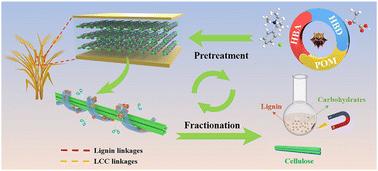磁性可回收钒取代磷钨酸在深共晶溶剂中用于麦秸的有效分馏
IF 9.2
1区 化学
Q1 CHEMISTRY, MULTIDISCIPLINARY
引用次数: 0
摘要
研究了一种磁性可回收的多金属氧酸盐(POM)催化剂辅助深度共晶溶剂(DES)体系,该体系能有效地对麦秸进行分馏,促进碳水化合物部分的酶解糖化,并对木质素部分进行活化。将POM引入到苯三乙基氯化铵/乳酸DES体系中,在120℃下反应2 h,麦秸中木质素的分离率为86.70%,木聚糖的分离率为91.22%,葡聚糖在生物质中保留率为93.81%。有效地解构麦秸顽固细胞壁结构,使预处理生物量葡聚糖消化率显著提高至97.20%。POM/ des分馏木质素纯度高(~ 98%),多分散性低(1.55),β-O-4结构保存良好(35.80/100 Ar),有利于后续利用工艺。重要的是,POM/DES体系易于通过简单的磁性方法回收,并且在5次循环中表现出优异的回收性能。本研究提出了一种绿色的DES分馏过程,该过程由易于回收的磁性POM催化剂辅助,以实现可持续和综合的生物质增值策略。本文章由计算机程序翻译,如有差异,请以英文原文为准。

Magnetically recyclable vanadium-substituted phosphotungstic acid in a deep eutectic solvent for effective wheat straw fractionation
A magnetically recyclable polyoxometalate (POM) catalyst-assisted deep eutectic solvent (DES) system was developed to effectively fractionate wheat straw, promote enzymatic saccharification of the carbohydrate fraction, and valorize the lignin fraction. With the introduction of POM to the benzyl triethylammonium chloride/lactic acid DES system, 86.70% lignin and 91.22% xylan were fractionated from wheat straw at 120 °C for 2 h, while glucan was well retained in the biomass (93.81%). Effective deconstruction of the recalcitrant cell wall structure of wheat straw made a significant enhancement in the glucan digestibility of pretreated biomass to 97.20%. POM/DES-fractionated lignin showed high purity (∼98%), low polydispersity (1.55), and well-preserved β-O-4 structure (35.80/100 Ar), beneficial for its subsequent utilization processes. Importantly, the POM/DES system was readily recycled through a simple magnetic method and exhibited excellent recycling performance in five cycles. This study presented a green DES fractionation process assisted by a readily recyclable magnetic POM catalyst for accomplishing a sustainable and integrated biomass valorization strategy.
求助全文
通过发布文献求助,成功后即可免费获取论文全文。
去求助
来源期刊

Green Chemistry
化学-化学综合
CiteScore
16.10
自引率
7.10%
发文量
677
审稿时长
1.4 months
期刊介绍:
Green Chemistry is a journal that provides a unique forum for the publication of innovative research on the development of alternative green and sustainable technologies. The scope of Green Chemistry is based on the definition proposed by Anastas and Warner (Green Chemistry: Theory and Practice, P T Anastas and J C Warner, Oxford University Press, Oxford, 1998), which defines green chemistry as the utilisation of a set of principles that reduces or eliminates the use or generation of hazardous substances in the design, manufacture and application of chemical products. Green Chemistry aims to reduce the environmental impact of the chemical enterprise by developing a technology base that is inherently non-toxic to living things and the environment. The journal welcomes submissions on all aspects of research relating to this endeavor and publishes original and significant cutting-edge research that is likely to be of wide general appeal. For a work to be published, it must present a significant advance in green chemistry, including a comparison with existing methods and a demonstration of advantages over those methods.
 求助内容:
求助内容: 应助结果提醒方式:
应助结果提醒方式:


